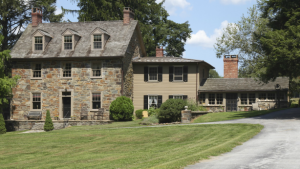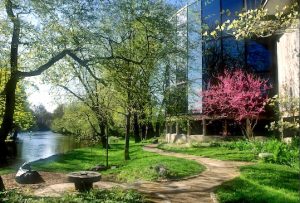For the 29th year, the Chadds Ford Historical Society will offer its popular Candlelight Christmas Tour, a stroll into the past that helps fund the society's historic mission.
The 2014 tour not only celebrates the 300-year history of the society’s 1714 Barns-Brinton House, but it also includes over 15 homes and historic sites in Pennsbury and Kennett Townships, all decked out in holiday style – and one of which served as a former Hollywood movie set.
The festive tour will include:
The Chadds Ford Historical Society Barn
The Barn Visitors’ Center, designed by noted local architect, John Milner, will be open from 11 a.m. to 3 p.m. Tickets for the day are available there and restroom facilities will be open for your use. Parking is behind the barn and can be utilized as a gathering spot for those who want to carpool with friends.
The Christian C. Sanderson Museum
Tour participants can park in the Brandywine Prime parking lot and walk to the Christian C. Sanderson Museum, which houses over 200 years of American History – and some of the quirkiest artifacts one could imagine. Many of those objects are from the local area and highlight items from the Revolutionary War, the Battle of the Brandywine, and also include the Civil War and both World Wars. Sanderson, a well-known teacher and fiddler, grew up with the Wyeths, and some original works of art by the Wyeth family are on display. The museum will be open from 10 pm. to 3 pm.
Downstream Farm

On nearby Meetinghouse Road, Downstream Farm is better known to locals as the “Marley and Me” House, from the Hollywood movie that was filmed on the 16-acre property. Built by the Hayes family in 1837, it retains much of its original charm. It was constructed with high ceilings and large rooms flooded with natural light, features not usually found in a typical Chester County farmhouse. There are two walk-in fireplaces, lovely exterior stonewalls, a Brandywine Creek feeding stream, and remnants of the old barn foundation, which serves as a landscape decoration.
William Brinton 1704 House
Listed on the National Register of Historic Places and also as a National Historic Landmark, the William Brinton House now serves as a museum and genealogical research center. This 13-acre property will open its doors to the barn, the carriage house, and even the privy, providing a unique glimpse of 18th -century English Quaker family living. It was built in 1704 by William Brinton, Jr., a Quaker who emigrated from Birmingham, England, in 1684. His family was instrumental in establishing Birmingham Township, where the stone for the post-medieval style house, still owned by the Brinton Association of America, was quarried.
Hillendale
Originally part of a 500-acre 1691 land grant by William Penn, the small, original structure of this 1780-90 home on Fairville Road underwent some add-ons, evidenced by the Greek Revival elements, which would date those additions to the mid-19th-century. In the early 1920s, the Danby family used the house as a summer property and hired renowned architect R. Brognard Okie to expand and renovate the old section of the residence. Okie was known for his use of period materials and when they were not available, he had them custom made.
Pennsbury Mill
This hydroelectric mill was built in 1919 by the owners of Hillendale to provide the power for their summerhouse. Mrs. Danby was related to Thomas Edison, and he provided the equipment to generate power. The original meters and controls are still located in a dining room cabinet in the home. It is suspected that while Okie was restoring and adding on to the main house, he added ideas for the mill since it was part of the property at the time. Later owners donated the mill to the township, and it was subsequently restored to its present state.
The Caleb Windle Farm (available by shuttle from Hillendale Elementary, due to traffic and parking issues)
This farm sits on just over two acres, down from the original 58 acres purchased for $2,820 by brothers Sharpless and Caleb Windle in March 1843. Sharpless Windle sold out to his brother early in 1844, and several months later, Caleb Windle oversaw construction of the eight-room fieldstone farmhouse that still stands. The current homeowners bought the farm in 2005 and had the kitchen redone several years later. They brought an eclectic mix of family pieces and treasures into the residence, which features a farm wagon, a rustic sleigh, and carriages as you near the front door. A restored 1911 Model T sits in the carriage house.
Chester County Barn (available by shuttle from Hillendale Elementary, due to traffic and parking issues)
This barn, which accompanied the Caleb Windle House, is featured on period land maps along with the residence. Since the needed farm animals working the land required shelter, their quarters were a first priority in erecting farm buildings. As was common in the 19th century, the barn was built from stone and tree materials gleaned from the property. These indigenous materials were also incorporated into the conical supports for an original overhanging section of the barn and the foundation and walls. A former residence of Vice-President Joe Biden’s sister, the barn provides an illustration of successful repurposing animal quarters into a home.
The Tenant House (available by shuttle from Hillendale Elementary, due to traffic and parking issues)
This circa-1830 tenant fieldstone farmhouse has evolved over the years. Originally part of a 172-acre parcel, the property served as temporary quarters for families getting established in the area in the 1900s. In the 1960s, it was found to be vacant and considered haunted by local children. The acreage dwindled and changed hands often until it was purchased by the current homeowner’s husband in 1981. After being unoccupied for years, it was restored and modernized. Additions were added in a board and batten style to blend in with the original dwelling, and the kitchen was updated with cypress cabinetry and paneling, soapstone counters, and a radiant heated brick floor, giving it a period look.
1840 Farm House
Joseph Pennock, who emigrated from County Tipperary, Ireland, obtained this land parcel in 1701 from William Penn when it comprised over 500 acres. He kept the property awhile and then sold it to Samuel Levis, and he ironically ended up marrying Samuel’s daughter, Mary, in 1705. By 1710, Joseph and Mary had moved to West Marlborough Township where Joseph had acquired 1,250 acres from his grandfather. After giving 550 acres to his son, Joseph and Mary had 700 acres to start building their home, now known as Primitive Hall. By the late 1950s, the now-eight-acre property was purchased by another well-known local name, Wyeth. Originally called Greenwood Hall, this 170-year-old dwelling was thought to be a part of the Underground Railroad.
Old Kennett Quaker Meeting House
First constructed in 1710, this meetinghouse sat on land owned by Ezekiel Harlan who acquired it as part of a William Penn land grant. It was used for worship by Quakers in the area, and the adjacent cemetery is considered the starting point of the Battle of the Brandywine when shots were first fired there on Sept. 11, 1777. General Maxwell was successful in driving back the troops to the North Hills of Chadds Ford, but soldiers who were killed in the skirmish are buried in the adjoining cemetery. The Meeting House was placed on the National Register for Historic Places in 1974 and celebrated its tercentennial in 2010; it continues to be open for meeting for worship on the last Sunday of June, July, and August at 11 a.m.
The Farmhouse at Kendal
This property was purchased in 1698 from a Pennock parcel that also originated from William Penn. The farmhouse was constructed in 1727 by Daniel and Mary Webb and additions were finished by 1826. The original deed to the property will be on display, and three of the first-floor rooms and the front hall will be graced with festive holiday decorations. In 1891, the property was purchased by William Hoopes and renamed “Lawnwold,” serving as a dairy, peach, and vegetable farm that had customers who reached to New York City. Light refreshments will be served and rest facilities will be available.
The Pennsbury Inn (a shuttle will run from the Pennsbury Township Building)
Another Penn Land Grant yielded the first section of the inn when it was erected in 1714. The current owners have a complete listing of owners to the present day. Legend has it that the carved signatures that grace the building are the proud craftsmen who worked on the structure. In 1749, the owners petitioned the township elders for a permit to add a “great expansion.” The addition was halted mid-construction when the fireplace footers had not been dug deep enough, prompting the chimney that served several fireplaces to sink, twisting the structure. It took almost 10 years to right the expansion, and in 1759 a dining room and summer kitchen were also added to the structure.
Architect John Milner’s Studio (park at the Pennsbury Antique Mall, Chadds Ford Winery or Pond’s Edge business complex)
John Milner, who specializes in the restoration and recreation of 18th-century properties, will offer a tour of the offices for the 20 people who work there. Photographs will show examples of the homes he has created and those he has expanded. Interesting artifacts and antiques pieces mixed in with holiday finery will also be on display.
ChaddsFord Winery and Farmhouse
Located on a former dairy farm, the winery has incorporated its equipment, a tasting room, and a shop into the existing barn for the farmhouse. The 1700s farmhouse has later additions, as well as a contemporary kitchen, and the first floor will be decorated and furnished for the holidays by Lisa Vonderstuck of Brandywine View Antiques to resemble an 18th-century tavern. Ticket-holders will be offered a five-beverage tasting in the tasting room on the tour day. The winery is one of the oldest in this region, having started in 1982.
Barns-Brinton House
Three hundred years ago, William Barnes had the foresight to establish a brick tavern on the main road between Philadelphia and Maryland. In 1722, the tavern received its first license to serve the public and that continued on until 1731 when Barnes died. During the next 22 years, the tavern changed hands several times until it was purchased by the grandson of one of the earliest settlers in the area, William Brinton. James Brinton held the title through the Battle of the Brandywine, when the tavern sustained damage, and his heirs continued ownership for over 100 years. In 1969, the Chadds Ford Historical Society purchased the property to restore it and showcase it as a 16th-century tavern with period furnishings. Its interior woodwork, paneling, and hardware, probably made by William Barnes, remain largely intact.
Tickets for the tour are $20 in advance or $25 per person on Dec. 6, the day of the tour. They are available for sale at the Chadds Ford Historical Society; Bryn Mawr Trust, 1620 Baltimore Pike, Chadds Ford; or Brandywine View Antiques, 1301 Brinton Bridge Rd, Chadds Ford, 19317. For more information, visit http://www.chaddsfordhistory.org/events/candlelight-christmas-tour/2014-the-details/.





Comments